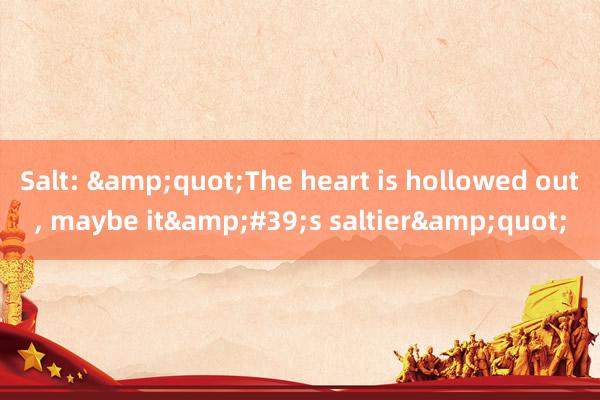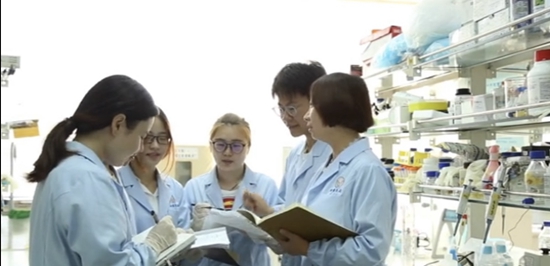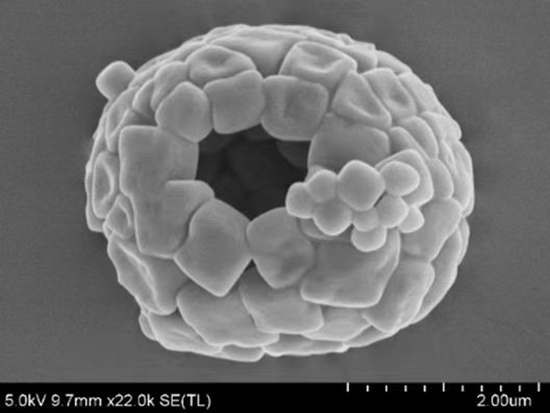On October 24, 2022, in Wudi County, Binzhou, Shandong, workers were harvesting autumn salt. Photo provided by Visual China Li Yuan (first from right) is with the student. Image provided by the interviewee hollow salt microsphere scanning electron m...


On October 24, 2022, in Wudi County, Binzhou, Shandong, workers were harvesting autumn salt. Photo provided by Visual China

Li Yuan (first from right) is with the student. Image provided by the interviewee

hollow salt microsphere scanning electron microscope. Picture provided by the interviewee
“Two iron balls land at the same time”There are two grains of salt here, one is solid and the other is hollow. Let's guess which one is saltier and which one is more friendly to health?
At China Agricultural University, professor Li Yuan led his students to "empty &rdquo". This group of researchers from the School of Food Science and Nutritional Engineering processed ordinary crystal salt into tiny, hollow “ salt balls ” These spheres have a particle size of only 5 microns, almost one percent of ordinary salt particles. In a sense, they are covered with &ldquoise "salt crust" air, but for human taste, they are more salty than ordinary salt.
This means that we may be able to enjoy the “ heavy taste ” while “ reduce salt ” while.
Taste game
The small salt balls piled up together and looked like snow-white flour. Because they are hollow, they are light and breathe, and they will scatter like water mist in the air. Sprinkle a pinch in your mouth, like a needle touching the tip of your tongue, and it feels irritating, and the salty taste stays in your mouth for a long time.
In contrast, to achieve this saltiness, more amounts must be added.
This is a taste game.
Li Yuan explained that the reason why people can eat salty taste is because the taste buds on the tongue are distributed to perceive various flavors. The sodium ions in table salt can enter the salty channel after being dissolved in saliva. If salts of equal mass are larger and have more particles, the surface area will be significantly larger when contacting the salt particles of the taste buds.
“equivalent to put sodium ions ‘slip ’ on the taste buds. ”Li Yuan said that this means that more sodium ions can be directly dissolved in saliva and enter the salty channel, “ Theoretically, making salt into hollow balls can create a saltier taste with fewer sodium ions. ”The hollow structure can prolong the retention time of sodium ions in the oral cavity, making the salty aftertaste longer.
Since ancient times, &ldquo "national control of salt" has never changed. This kind of condiment seems to be very daily and most important. However, with the development of productivity and social progress, it is no longer rare for ordinary people, and they may even need to eat less.
The main ingredient of salt is sodium chloride. Too much sodium intake in the human body will have adverse effects on blood pressure and kidneys. The latest "Diet Guidelines for Chinese Residents (2022)" recommends that Chinese residents over 11 years old consume no more than 5 grams of salt per day. A pack of potato chips with a net weight of 135 grams contains about 1 gram of salt. If you eat one pack, you will eat one fifth of the recommended salt intake.
In the past 40 years, Chinese adults have eaten an average of 9.3 grams of salt per day. Researchers from the School of Medicine of Queen Mary University in London, UK compiled models using data such as China's current region, population, age, salt intake, blood pressure, and diseases. They predict that if the per capita salt reduction can be achieved by 1 gram within one year, it can effectively reduce people's risk of hypertension and reduce people's average systolic blood pressure by about 1.2 mmHg. According to their model, if this salt reduction target is adhered to, China could prevent nearly 9 million heart attacks and stroke cases and save 4 million lives by 2030.
The Chinese need "reduce salt" and it is imperative. However, who loves food, who can give up the rich stir-fry, delicious braised dishes, spicy hot pot, and delicious soup … … … … … … … … … … … … … … … … … … … … … … … … … … … … … … … … … … … … … … … … … … … … … … … … … … … … … … … … ?
It is not difficult to ask this question, but it is not easy to replace or reduce the amount of salt in food. There is no such thing as xylitol on the market that can replace salt sprinkled on potato chips, cold dishes, and spicy strips.
Contribute more salty taste, and cause less burden
Li Yuan claims to be “ "Big Enlightenment" and is always pursuing "Innovation"” “ Invention” After completing her undergraduate degree at China Agricultural University, she went to the Netherlands to continue her studies and chose to pursue her doctorate in the direction of "food colloids and physical chemistry".
This is a discipline with obvious “ crossover ” it helps Li Yuan find solutions to the problem from a more diverse “ tools ” After returning to China to teach, she has been trying to break through various researches in the food industry “bottleneck;”. Salt is one of them.
The Northern Song Dynasty writer Liu Yong once described the hardships of salt people making salt in "Song of the Sea": “Furious in the morning and shine in the evening, the waves turn into snow. ”Now, the salt manufacturing industry no longer needs to be so ignorant of manpower, and Li Yuan led the student team to study and improve salt, which is full of joy of thinking.
Li Yuan discovered early on that few people specialize in salt reduction technology. The industry consensus is that reducing salt is not easy to reduce sugar.
“The mechanism of stimulating sweetness and saltyness is different. ”Li Yuan said that there are many substances that can activate the “sweet receptors on the taste buds, so “sugar ”it is easy to replace. However, only sodium ions can make humans feel the best saltiness.
It is difficult to artificially manufacture &ldquo of sodium ions. At present, the true sodium salt substitute is still in the experimental stage. Food researchers have tried various “ reducing salt ” and added potassium chloride, ammonium chloride, polypeptide and other substances to sodium chloride to form low-sodium salts. To a certain extent, adding low sodium salts of potassium chloride can help the human body achieve sodium-potassium balance and reduce the risk of cardiovascular and cerebrovascular diseases, but its disadvantages are also obvious. Potassium chloride will produce a bitter taste and affect the taste of food.
Sodium chloride is still the best choice. It tastes good, but you can't eat too much. Li Yuan found that humans are ingesting some sodium ions that do not contribute salty flavor every day, such as solid salt on potato chips, which are solid cubic crystals at millimeter scale. When people eat, only a layer of sodium ions on the surface of the crystal may be dissolved in saliva and enter the taste buds "exclusive salty channel". There is also a part of sodium chloride that we swallowed before it was dissociated by saliva; — they did not contribute a salty taste, but would directly enter the body to increase salt intake.
A kind of spatial imagination enters Li Yuan's brain. She thought about whether it could optimize the physical form of salt, change the particle size, density and surface area of salt, so that more sodium ions can enter the oral cavity and play a salty role, and allow fewer sodium ions to enter the abdominal cavity and reduce the burden on the organs.
She decided to give it a try and empty the salt.
“We make ordinary solid salt into 5 micron hollow salt microspheres. ”Li Yuan explained that this is a change in the microscopic world, “ it is like a piece of latex to make 100 hollow balloons. &rdquo: "The hollowed out salt uses the same quality of materials as ordinary table salt, but the number of salt particles increases, and the total surface area becomes larger. In the world of taste buds, they melt more thoroughly, and the efficiency is higher.
The experimental process of preparing hollow salt is not complicated. Li Yuan’s team designed a special solution to dissolve table salt.
Under an electron microscope that is magnified hundreds of thousands of times, it can be seen that sodium chloride enters the solution, is decomposed into individual particles, reorganizes in dispersion, and finally accumulates into tiny hollow spheres after another, and the “ shell ” of the sphere is composed of previously broken sodium chloride. Then, the solution was sucked into the instrument and dried, and the snow fell to the gate.
“The most difficult part is to study the special process and formula of the solution to create a stable structure for the hollow salt. &rdquo: This study has been going on for three years, Li Yuan joked that the secret recipe is more suitable for Chinese babies' physical condition. She added that there are indeed similar technologies abroad for salt, but the cost is high, and the volume of thin hollow salt flakes produced is about the same as that of ordinary salt granules.
Li Yuan's team reduced the volume of salt particles to the extreme, and recently made hollow salt microspheres with particle sizes of several hundred nanometers.
For scientific research, this female scholar is never afraid of "failure" and encourages students to do "things that others have not done before". Domestic food industry, such as milk powder and high-end functional base material manufacturing, also has technologies that are "bottlenecked" from abroad, and these problems require food science and technology workers to overcome them.
Scientists will keep moving forward
At present, the &ldquoise "hollow ball" of Li Yuan's team is limited to the food that can cooperate.
Because salt dissolves in water, the ball-like hollow structure will disintegrate in water. In other words, it can trick the tongue at present, but it can't cheat water. Sprinkle on potato chips and use them as seasoning oil, which is so salty that it is fine, but a bowl of hot soup may bring it back to its original form. However, it also has a hidden feature, which is that it can perform stably in room temperature oil. The oil is its “ Raincoat ”.
According to these characteristics, Li Yuan wants to write a “ Instructions for hollow salt ””— Our salt is suitable for use when the dishes are about to be released from the pot; when mixing cold dishes, please mix the hollow salt with sesame oil and pepper oil first, and then sprinkle it; when mixing salad, please add it to the salad dressing first to avoid contact between salt and water “…
In order to break the usage restrictions of “ in food cooking, Li Yuan envisions that in the future, cover the surface of hollow salt microspheres with a layer of film, so that it can maintain a stable structure in water or other special environments, increase the use scenario, stir-fry, rinse, and cook.
It is understood that the production cost of this hollow salt is not high and does not contain any food additives. It has been tested in many companies. A catering company sprinkled hollow salt on small crispy meat, which proved that it could reduce salt by 40%; a snack company conducted a test in products such as fries, which proved that it could reduce salt by 55%.
Is salt necessarily white? Why can't it be colored? Small pigments of different colors may also have antioxidant activity, further improving the health and friendship of hollow salt …… Li Yuan wants to make hollow salt into a personalized, multifunctional, healthy and new concept condiment. She once again opened her mind: “Since hollow salt is hollow, it can hold things, and can introduce umami substances, flavor substances, spicy substances, and even some other substances. ”
Although I really want to promote the “ small balls ” born in my brain, Li Yuan still believes that hollow salt microspheres do not need to completely replace ordinary salt. “People can avoid sugar for a day, but they must not eat salt. ”She said that sodium, as a substance that the human body must consume, does not need to be overly nervous, as long as it meets the health standards, “ What hollow salt needs to solve is the excess salt. ”
The food cabinets in the industrial world, potato chips, biscuits, spicy strips and other snack products are always contributing “ excess ” fat, carbohydrates and salt. If hollow salt can be used to reduce salt for these snacks, it can effectively help people reduce their salt intake.
Li Yuan also believes that reducing salt is not only a technical issue, but also a consciousness issue. She found that when consumers buy food, they pay attention to sugar and fat content, but rarely pay attention to sodium content. Some people think that as long as you eat it normally is not salty, your salt intake will not be excessive. But that's not the case, and the salty taste is often hidden in other flavors. It is unreliable to judge the level of salt by taste alone. Some desserts, such as cheese, ice cream, cakes, etc., taste sweet and have nothing to do with the saltiness, but salt is added during the production process.
Contemporary urbanites are pursuing healthy diets that reduce sugar and fat. Low-salt foods have not yet been able to replicate the popularity of low-saccharide and low-fat foods. Low sugar and low fat really capture people's current weight and body anxiety, while the harm caused by high-salt foods is often gradual and it takes more than ten or even decades to be perceived by people. &ldquo: "The long-term Chinese dietary habits make it difficult for people to give up &lsquo: "Seasoning &rsquo." We have been exposed to more strong smells since childhood, and the threshold for Chinese taste perception is also higher. ”Li Yuan said that she is a mother of two children and found that the snacks her children eat every day, "a pack of salt contains more than the daily intake standard." Judging from her experience studying in the Netherlands, local children did not know the sweetness and saltiness before they were two years old, because all children's food in the Netherlands had strict standards on the amount of sugar and salt added.
“In a short period of time, the awareness of salt reduction cannot be improved and the dietary habits cannot be changed. Scientific researchers must further explore strategies for salt reduction from a technical perspective. &rdquo: In Li Yuan's vision, there will be the second, third or even the Nth generation of hollow salt. &ldquo: Scientists will not stop, they will keep moving forward. ”